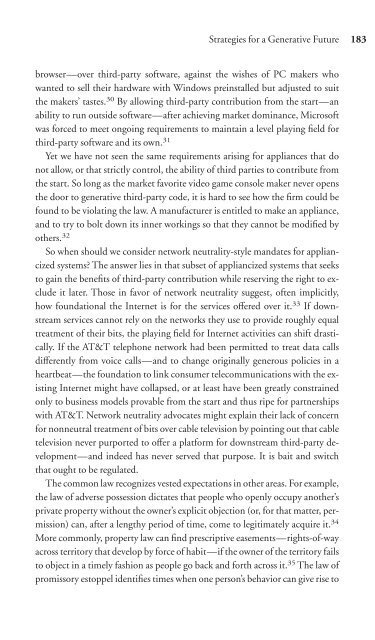Download - Future of the Internet â And how to stop it.
Download - Future of the Internet â And how to stop it.
Download - Future of the Internet â And how to stop it.
You also want an ePaper? Increase the reach of your titles
YUMPU automatically turns print PDFs into web optimized ePapers that Google loves.
Strategies for a Generative <strong>Future</strong> 183<br />
browser—over third-party s<strong>of</strong>tware, against <strong>the</strong> wishes <strong>of</strong> PC makers who<br />
wanted <strong>to</strong> sell <strong>the</strong>ir hardware w<strong>it</strong>h Windows preinstalled but adjusted <strong>to</strong> su<strong>it</strong><br />
<strong>the</strong> makers’ tastes. 30 By allowing third-party contribution from <strong>the</strong> start—an<br />
abil<strong>it</strong>y <strong>to</strong> run outside s<strong>of</strong>tware—after achieving market dominance, Micros<strong>of</strong>t<br />
was forced <strong>to</strong> meet ongoing requirements <strong>to</strong> maintain a level playing field for<br />
third-party s<strong>of</strong>tware and <strong>it</strong>s own. 31<br />
Yet we have not seen <strong>the</strong> same requirements arising for appliances that do<br />
not allow, or that strictly control, <strong>the</strong> abil<strong>it</strong>y <strong>of</strong> third parties <strong>to</strong> contribute from<br />
<strong>the</strong> start. So long as <strong>the</strong> market favor<strong>it</strong>e video game console maker never opens<br />
<strong>the</strong> door <strong>to</strong> generative third-party code, <strong>it</strong> is hard <strong>to</strong> see <strong>how</strong> <strong>the</strong> firm could be<br />
found <strong>to</strong> be violating <strong>the</strong> law. A manufacturer is ent<strong>it</strong>led <strong>to</strong> make an appliance,<br />
and <strong>to</strong> try <strong>to</strong> bolt down <strong>it</strong>s inner workings so that <strong>the</strong>y cannot be modified by<br />
o<strong>the</strong>rs. 32<br />
So when should we consider network neutral<strong>it</strong>y-style mandates for appliancized<br />
systems The answer lies in that subset <strong>of</strong> appliancized systems that seeks<br />
<strong>to</strong> gain <strong>the</strong> benef<strong>it</strong>s <strong>of</strong> third-party contribution while reserving <strong>the</strong> right <strong>to</strong> exclude<br />
<strong>it</strong> later. Those in favor <strong>of</strong> network neutral<strong>it</strong>y suggest, <strong>of</strong>ten implic<strong>it</strong>ly,<br />
<strong>how</strong> foundational <strong>the</strong> <strong>Internet</strong> is for <strong>the</strong> services <strong>of</strong>fered over <strong>it</strong>. 33 If downstream<br />
services cannot rely on <strong>the</strong> networks <strong>the</strong>y use <strong>to</strong> provide roughly equal<br />
treatment <strong>of</strong> <strong>the</strong>ir b<strong>it</strong>s, <strong>the</strong> playing field for <strong>Internet</strong> activ<strong>it</strong>ies can shift drastically.<br />
If <strong>the</strong> AT&T telephone network had been perm<strong>it</strong>ted <strong>to</strong> treat data calls<br />
differently from voice calls—and <strong>to</strong> change originally generous policies in a<br />
heartbeat—<strong>the</strong> foundation <strong>to</strong> link consumer telecommunications w<strong>it</strong>h <strong>the</strong> existing<br />
<strong>Internet</strong> might have collapsed, or at least have been greatly constrained<br />
only <strong>to</strong> business models provable from <strong>the</strong> start and thus ripe for partnerships<br />
w<strong>it</strong>h AT&T. Network neutral<strong>it</strong>y advocates might explain <strong>the</strong>ir lack <strong>of</strong> concern<br />
for nonneutral treatment <strong>of</strong> b<strong>it</strong>s over cable television by pointing out that cable<br />
television never purported <strong>to</strong> <strong>of</strong>fer a platform for downstream third-party development—and<br />
indeed has never served that purpose. It is ba<strong>it</strong> and sw<strong>it</strong>ch<br />
that ought <strong>to</strong> be regulated.<br />
The common law recognizes vested expectations in o<strong>the</strong>r areas. For example,<br />
<strong>the</strong> law <strong>of</strong> adverse possession dictates that people who openly occupy ano<strong>the</strong>r’s<br />
private property w<strong>it</strong>hout <strong>the</strong> owner’s explic<strong>it</strong> objection (or, for that matter, permission)<br />
can, after a lengthy period <strong>of</strong> time, come <strong>to</strong> leg<strong>it</strong>imately acquire <strong>it</strong>. 34<br />
More commonly, property law can find prescriptive easements—rights-<strong>of</strong>-way<br />
across terri<strong>to</strong>ry that develop by force <strong>of</strong> hab<strong>it</strong>—if <strong>the</strong> owner <strong>of</strong> <strong>the</strong> terri<strong>to</strong>ry fails<br />
<strong>to</strong> object in a timely fashion as people go back and forth across <strong>it</strong>. 35 The law <strong>of</strong><br />
promissory es<strong>to</strong>ppel identifies times when one person’s behavior can give rise <strong>to</strong>


